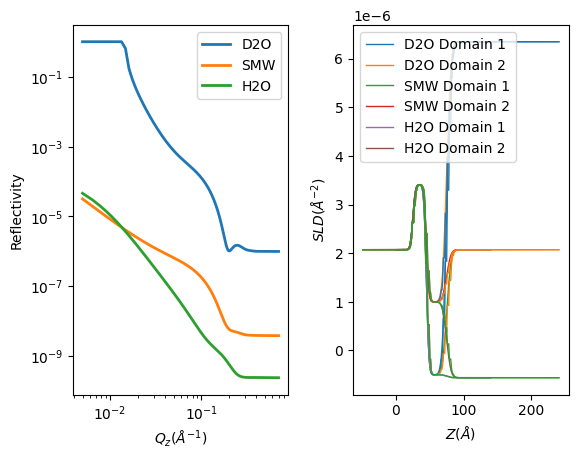Note
To get the output project and results from this example in your Python session, run:
from ratapi.examples import domains_custom_XY
project, results = domains_custom_XY()
[1]:
import pathlib
from IPython.display import Code
import ratapi as RAT
from ratapi.models import Parameter
Simple example of a layer containing domains using a custom XY model#
Domains custom XY models operate in the same way as domains custom layer models, in that there is an additional input to the custom model specifying the domain to be calculated:
This is then used within the function to calculate the correct SLD profile for each contrast and domain. In this example, we simulate a hydrogenated layer on a silicon substrate, containing domains of a larger SLD, against D2O, SMW and water.
Start by making the project and adding the parameters:
[2]:
problem = RAT.Project(calculation="domains", model="custom xy", geometry="substrate/liquid")
parameter_list = [
Parameter(name="Oxide Thickness", min=10.0, value=20.0, max=50.0, fit=True),
Parameter(name="Layer Thickness", min=1.0, value=30.0, max=500.0, fit=True),
Parameter(name="Layer SLD", min=-0.5e-6, value=-0.5e-6, max=0.0, fit=True),
Parameter(name="Layer Roughness", min=2.0, value=5.0, max=7.0, fit=True),
Parameter(name="Domain SLD", min=1.0e-6, value=1.0e-6, max=5.0e-6, fit=True)
]
problem.parameters.extend(parameter_list)
Now set the SLDs of the bulk phases for our samples.
[3]:
problem.bulk_in.set_fields(0, name="Silicon", value=2.073e-6, max=1.0, fit=False)
problem.bulk_out.append(name="SLD SMW", min=2.0e-6, value=2.073e-6, max=2.1e-6)
problem.bulk_out.append(name="SLD H2O", min=-0.6e-6, value=-0.56e-6, max=-0.5e-6)
problem.scalefactors.set_fields(0, min=0.8, value=1.0, max=1.1, fit=True)
The custom file takes the parameters and build the model as usual, changing the SLD of the layer depending on whether we are calculating the layer (domain = 0), or the domain (domain = 1).
[4]:
Code("domains_XY_model.py")
[4]:
"""Custom model file for the domains custom XY example."""
import math
import numpy as np
def domains_XY_model(params, bulk_in, bulk_out, contrast, domain):
"""Calculate the SLD profile for a domains custom XY model."""
# Split up the parameters for convenience
subRough = params[0]
oxideThick = params[1]
layerThick = params[2]
layerSLD = params[3]
layerRough = params[4]
domainSLD = params[5]
# Make an array of z values for our model
z = np.arange(0, 141)
# Make the volume fraction distribution for our Silicon substrate
[vfSilicon, siSurf] = makeLayer(z, -25, 50, 1, subRough, subRough)
# ... and the Oxide ...
[vfOxide, oxSurface] = makeLayer(z, siSurf, oxideThick, 1, subRough, subRough)
# ... and also our layer.
[vfLayer, laySurface] = makeLayer(z, oxSurface, layerThick, 1, subRough, layerRough)
# Everything that is not already occupied will be filled will water
totalVF = vfSilicon + vfOxide + vfLayer
vfWater = 1 - totalVF
# Now convert the Volume Fractions to SLDs
siSLD = vfSilicon * bulk_in
oxSLD = vfOxide * 3.41e-6
# Layer SLD depends on whether we are calculating the domain or not
if domain == 0:
laySLD = vfLayer * layerSLD
else:
laySLD = vfLayer * domainSLD
# ... and finally the water SLD.
waterSLD = vfWater * bulk_out[contrast]
# Make the total SLD by just adding them all up
totalSLD = siSLD + oxSLD + laySLD + waterSLD
# The output is just a [n x 2] array of z against SLD
SLD = np.column_stack([z, totalSLD])
return SLD, subRough
def makeLayer(z, prevLaySurf, thickness, height, Sigma_L, Sigma_R):
"""Produce a layer, with a defined thickness, height and roughness.
Each side of the layer has its own roughness value.
"""
# Find the edges
left = prevLaySurf
right = prevLaySurf + thickness
# Make our heaviside
a = (z - left) / ((2**0.5) * Sigma_L)
b = (z - right) / ((2**0.5) * Sigma_R)
erf_a = np.array([math.erf(value) for value in a])
erf_b = np.array([math.erf(value) for value in b])
VF = np.array((height / 2) * (erf_a - erf_b))
return VF, right
Finally, add the custom file to the project, and make our three contrasts.
[5]:
problem.custom_files.append(name="Domain Layer", filename="domains_XY_model.py", language="python", path=pathlib.Path.cwd().resolve())
# Make contrasts
problem.contrasts.append(
name="D2O",
background="Background 1",
resolution="Resolution 1",
scalefactor="Scalefactor 1",
bulk_in="Silicon",
bulk_out="SLD D2O",
domain_ratio="Domain Ratio 1",
data="Simulation",
model=["Domain Layer"],
)
problem.contrasts.append(
name="SMW",
background="Background 1",
resolution="Resolution 1",
scalefactor="Scalefactor 1",
bulk_in="Silicon",
bulk_out="SLD SMW",
domain_ratio="Domain Ratio 1",
data="Simulation",
model=["Domain Layer"],
)
problem.contrasts.append(
name="H2O",
background="Background 1",
resolution="Resolution 1",
scalefactor="Scalefactor 1",
bulk_in="Silicon",
bulk_out="SLD H2O",
domain_ratio="Domain Ratio 1",
data="Simulation",
model=["Domain Layer"],
)
Finally, run the simulation and plot the results.
[6]:
controls = RAT.Controls()
problem, results = RAT.run(problem, controls)
RAT.plotting.plot_ref_sld(problem, results)
Starting RAT ───────────────────────────────────────────────────────────────────────────────────────────────────────────
Elapsed time is 0.185 seconds
Finished RAT ───────────────────────────────────────────────────────────────────────────────────────────────────────────

